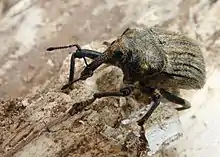Rhynchodes ursus
Rhynchodes ursus, or elephant weevil, is a wood-boring weevil found all over New Zealand.[2] Adult weevils are found on trees, where they gather to feed on sap. Larvae tunnel into dead trunks and branches of southern beeches, rimu and Dracophyllum traversii.[1] This large weevil has a deep brown colour with two lighter bands near the side of its thorax. It has black legs with a spot of yellowish-brown hairs on each femur.[3] It has dense scales on its body, which can be hair-like. In female specimens the antennae are inserted halfway along the rostrum and nearer the front in males.[1] The larvae of Rhynchodes ursus are the host of New Zealand's largest parasitic wasp, Certonotus fractinervis. Female wasps use a long ovipositor to lay eggs inside the larvae whilst they develop inside trees.[2]
| Rhynchodes ursus | |
|---|---|
 | |
| Scientific classification | |
| Kingdom: | Animalia |
| Phylum: | Arthropoda |
| Class: | Insecta |
| Order: | Coleoptera |
| Family: | Curculionidae |
| Genus: | Rhynchodes |
| Species: | R. ursus |
| Binomial name | |
| Rhynchodes ursus | |
References
- Lyal, Chris (1993). "Cryptorhynchinae" (PDF). Fauna of New Zealand. 29. Retrieved 25 February 2018.
- "Weevil (Elephant) Rhynchodes ursus". T.E.R:R.A.I.N - Taranaki Educational Resource: Research, Analysis and Information Network. Retrieved 25 February 2018.
- Richardson, John & Gray, John Edward (1844–1875). The zoology of the voyage of the H.M.S. Erebus & Terror, under the command of Captain Sir James Clark Ross, during the years 1839 to 1843. London: E. W. Janson. p. 16. Retrieved 26 February 2018.